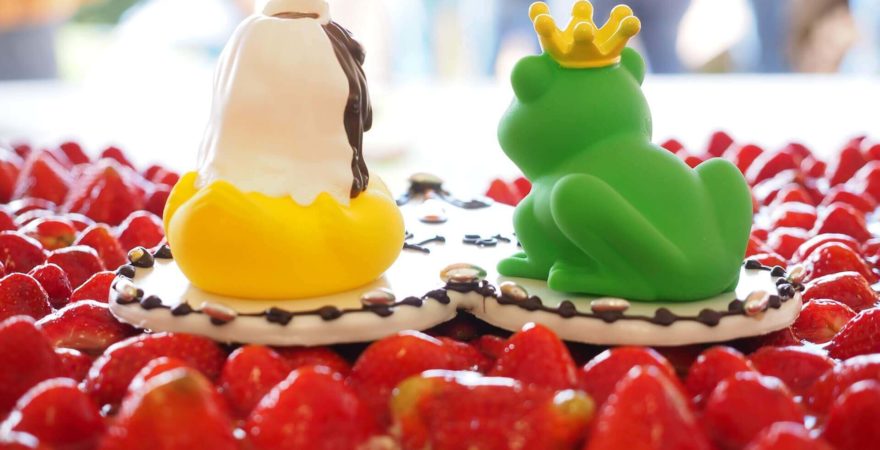A king cake sometimes shown as kingcake, kings' cake, king's cake, or three kings cake is a type of cake associated in a number of countries with the festival of Epiphany at the end of the Christmas season; in other places, it is associated with the pre-Lenten celebrations of Mardi Gras/Carnival.
What started out roughly 300 years ago as a dry French bread–type dough with sugar on top and a bean inside now comes in many varieties depending on the country. Some king cakes are made of a sweet brioche dough in the shape of a hollow circle with a glazed topping sprinkled with colored sugar. Hundreds of thousands of King Cakes are eaten in New Orleans during the Carnival season. In other countries, king cakes are made with a puff pastry, filled with one of several fillings e.g., almond, apple, chocolate/pear, etc., and have a small figurine hidden inside. The figurine changes from bakery to bakery and often represents a hit movie or other cultural icon.
The cake often has a small plastic baby (to represent the Baby Jesus) inside or underneath; and the person who gets the piece of cake with the trinket has various privileges and obligations.
The "king cake" takes its name from the biblical kings. In Western Christian liturgical tradition, the Solemnity of Epiphany—commemorated on January 6—celebrates the visit of the Magi to the Christ Child. The Eve of Epiphany (the night of January 5) is popularly known as Twelfth Night (the Twelve Days of Christmas are counted from Christmas Eve until this night). The season for king cake extends from the end of the Twelve Days of Christmas (Twelfth Night and Epiphany Day), up until the end of Shrovetide: Mardi Gras, "Fat Tuesday," or Shrove Tuesday; the day before the start of Lent. Some organizations or groups of friends may have "king cake parties" every week through the Carnival season. In Portugal and France, whoever gets the King cake trinket is expected to buy the next cake for these get-togethers.
It is a popular food item during the Christmas season (Christmas Eve to Epiphany) in Belgium, France, Quebec and Switzerland (galette or gâteau des Rois or galette des rois), Portugal (bolo rei), Spain and Latin America (roscón or rosca de reyes) and, Greece and Cyprus (vasilopita) and Bulgaria (banitsa). In the United States, Carnival is traditionally observed in the Southeastern region of the country, particularly in New Orleans, Bay Saint Louis, Mobile, Pensacola, Galveston, and other towns and cities of the Mississippi Gulf Coast.
In these regions, the king cake is closely associated with Mardi Gras traditions and is served throughout the Carnival season, which lasts from Epiphany Eve to Fat Tuesday.The King Cake tradition is thought to have been brought to New Orleans from France in 1870. Now, as part of the celebration, it is traditional to bake a cake (King Cake) in honor of the three kings. The official colors of Mardi Gras – created in 1872 by the Krewe of Rex – are purple for justice, green for faith, and gold for power.
Related culinary traditions are the tortell of Catalonia, the gâteau des Rois or reiaume in Provence or the galette des Rois in the northern half of France, and the Greek and Cypriot vasilopita. The galette des Rois is made with puff pastry and frangipane (while the gâteau des Rois is made with brioche and candied fruits). A little bean was traditionally hidden in it, a custom taken from the Saturnalia in the Roman Empire: the one who stumbled upon the bean was called "king of the feast." In the galette des Rois, since 1870 the beans have been replaced first by porcelain and now by plastic figurines.



